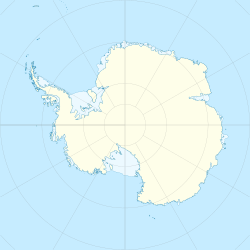Johnson Island (Antarctica) facts for kids
|
Location in Antarctica
|
|
| Geography | |
|---|---|
| Location | Antarctica |
| Coordinates | 72°52′S 93°54′W / 72.867°S 93.900°W |
| Administration | |
| Administered under the Antarctic Treaty System | |
| Demographics | |
| Population | Uninhabited |
Johnson Island is a unique island in Antarctica that is completely covered in ice. It's about 17 kilometres (9 nmi) long and 9 kilometres (5 nmi) wide. This icy island is located within a huge sheet of floating ice called the Abbot Ice Shelf. It lies about 26 kilometres (14 nmi) southeast of another island called Dustin Island.
Discovering Johnson Island
Johnson Island was first spotted and roughly mapped in February 1961. This happened during an expedition by a ship called the USS Glacier (AGB-4). The crew of the USS Glacier thought it was an "ice rise" at the time. An ice rise is like a small, dome-shaped hill of ice that sticks up from an ice shelf. It's often formed over a hidden piece of land or a shallow spot in the ocean floor.
Mapping the Icy Landscape
Later, in 1966, Johnson Island was mapped more accurately. This detailed mapping was done by the United States Geological Survey (USGS). The USGS used special air photos taken by the U.S. Navy. These photos helped them get a clearer picture of the island's shape and exact location.
How Johnson Island Got Its Name
The island was officially named by the Advisory Committee on Antarctic Names. This committee is responsible for naming places in Antarctica. They decided to name the island after Theodore L. Johnson. He was an electrical engineer who worked at Byrd Station during the years 1964 and 1965. Byrd Station was a research base in Antarctica.


